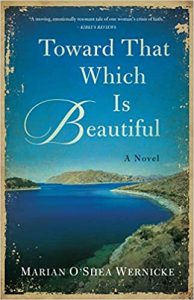On Autobiography in Fiction
 Readers of fiction often find themselves wondering how much of a story is based on the writer’s life. Recently, I was reading Colm Toibin’s book called On Elizabeth Bishop and came across a quotation from Kierkegaard on the delicate mixture of fiction and autobiography: “The law of delicacy, according to which an author has the right to use what he himself had experienced, is that he is never to utter a verity for himself & only to let it be refracted in various ways.”
Readers of fiction often find themselves wondering how much of a story is based on the writer’s life. Recently, I was reading Colm Toibin’s book called On Elizabeth Bishop and came across a quotation from Kierkegaard on the delicate mixture of fiction and autobiography: “The law of delicacy, according to which an author has the right to use what he himself had experienced, is that he is never to utter a verity for himself & only to let it be refracted in various ways.”
To me, the image of refraction of personal experience in fiction is perfect. The writer has grown up in a specific time and place, has met many people in life, and has read many books. So when one sits down to tell a story, images arise from both memory and the imagination, and gradually are woven thread by thread into a tapestry until the individual threads are indistinguishable and a new work is crafted.
I am thinking now of Tolstoy one morning at breakfast as he opens his newspaper to read an account of a local married woman, rumored to be having an affair, who has committed suicide by throwing herself under a train. Thus the seed of the doomed heroine of Anna Karenina, that perfect novel. Or we can remember William Faulkner’s character Dilsey in The Sound and the Fury, known to be based on Caroline Barr, the beloved nanny of Faulkner’s childhood, and to whom he dedicated his novel Go Down Moses.
So when readers ask me whether my novel Toward That Which is Beautiful is based on my own life, I can see why they might think that. After all, I was a nun for eleven years, and I did work in Peru for three of those years until I left the religious order. But how can I explain the fact that the answer to their question is both yes and no?
No, I am not the main character, Sister Mary Katherine or Kate. I never worked in the Altiplano of Peru, nor did I run away from the convent for eight days with no money and no destination. But, and this is the most honest answer, certainly many details of Kate’s early life are lifted from the mists of memory, just burnished and re-lit by the lamp of time past.
The section on Kate’s early years in the novitiate is the most autobiographical. It includes several slightly disguised characters such as the shell-shocked, pipe-smoking chaplain of the nuns and his golden retriever who accompanied him to every class, as well as the Belgian Benedictine priest who taught the novices Gregorian chant, and even the head sister in the convent kitchen who once scolded me for my lack of common sense. My former classmates of those days may recognize these people.
The first draft of a novel is written in a dream state, as day after day, one sits down to write, and the story unfurls in the imagination. Somehow the unconscious weaves in scenes and characters from the past into the fiction on the page. The physical setting too can be a product of memory, the smell of a place, the sounds, how it feels in different seasons.
In my novel, the novitiate that Kate enters out in the country west of St. Louis is based on the motherhouse and grounds of the religious order I entered all those years ago, with its orchard and groves of trees, where we were free to roam during our time of recreation or, at times, or to hide to weep silently when we were overcome with homesickness or doubt. Also, the description of the house in Juliaca where the sisters live is based on the convent in Lima where I lived for three years, but in a very different climate from the Altiplano.
But wait! Am I taking the mystery out of the readers’ experience? Rather than trying to ferret out what parts of the novel are “true”, I would hope that the reader, just like the airplane traveler, will sit back, relax, and enjoy the journey with the desperate, naive Kate, as she tries to escape her dilemma until the final illumination at the climax of her journey.
—
Marian O’Shea Wernicke was a nun for eleven years and spent three years working in Lima, Peru, during that time. She is a former professor of English and creative writing at Pensacola State College and the author of a memoir about her father called Tom O’Shea: A Twentieth Century Man. Her upcoming novel, Toward That Which is Beautiful is set to debut September 29, 2020.
TOWARD THAT WHICH IS BEAUTIFUL
 On an ordinary day in June of 1964 in a small town in the Altiplano of Peru, Sister Mary Katherine (formerly known as Kate), a young American nun recently arrived in this very foreign place, walks away from her convent with no money and no destination.
On an ordinary day in June of 1964 in a small town in the Altiplano of Peru, Sister Mary Katherine (formerly known as Kate), a young American nun recently arrived in this very foreign place, walks away from her convent with no money and no destination.
Desperate and afraid of her feelings for an Irish priest with whom she has been working, she spends eight days on the run, encountering a variety of characters along the way: a cynical Englishman who helps her out; a suspicious Peruvian police officer who takes her in for questioning; and two American Peace Corps workers who befriend her. As Kate traverses this dangerous physical journey through Peru, she also embarks upon an interior journey of self-discovery―one that leads her somewhere she never could have expected.
Category: On Writing
























